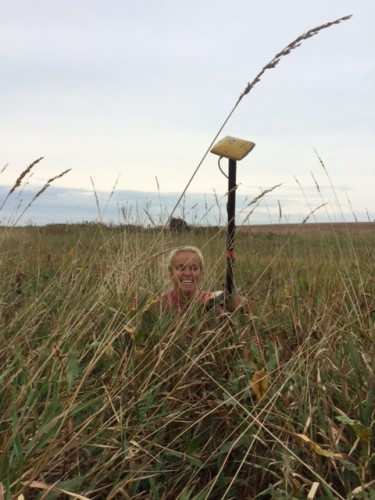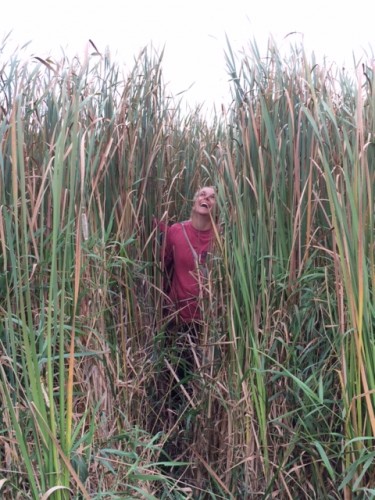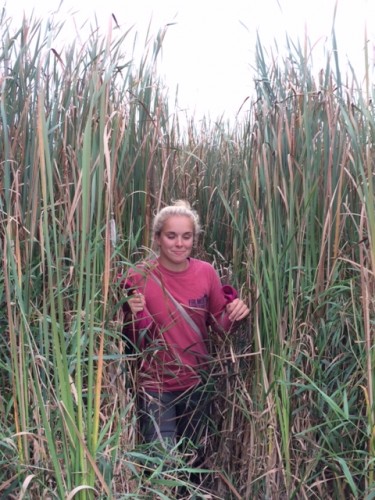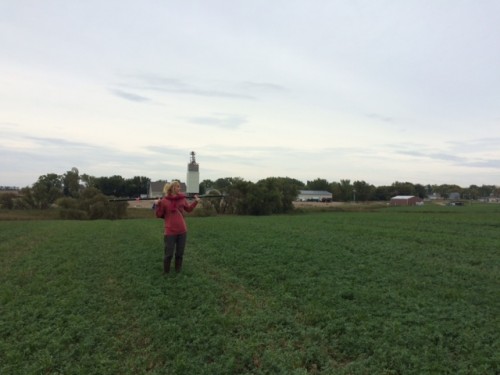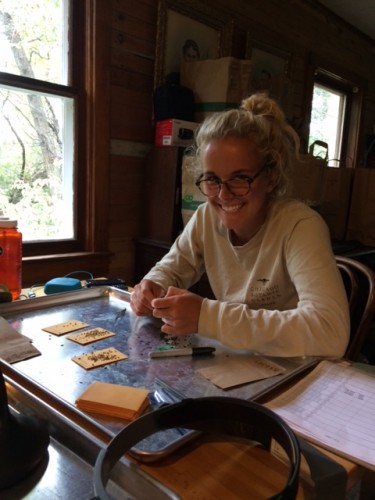|
|
Halfway through our first week of the externship, things have started getting exciting! While Belle has been busy cataloguing, Jackie and Audrey have made some new friends: larvae we’ve found living in the seed heads. The mystery larvae are unfortunately eating the achenes we’re trying to collect, but to make the most out of a bad situation, we’ve been collecting larvae, too! The count in our petri dish is about 8, and growing! Most of these have been found by Audrey, who in a twist of cruel irony is the most startled to find them. The larvae are pretty big relative to the head and easy to spot (they’re pale pink and the heads are dark brown), but we still haven’t figured out how to predict which achene we pull out will have a larva behind it. We still have a lot more heads to clean and find larvae in, so we hope to find out where they’re coming from and maybe even see what they turn into.
Pictured below: Jackie and Audrey’s first larval finds.
 
Hello! I have created a webpage that displays the different parts of an Echinacea angustifolia seedhead. It is available at: https://echinaceaproject.org/background/our-study-species/echinacea-seedheads/. The page defines the parts of a seedhead and many of the types of chaff found while cleaning heads, with pictures!
Monday the 30th of November marked the start of two exciting new externship projects in the lab. All three undergraduate students are from Carleton College. Belle Kinder is taking inventory and creating a database for bee specimens. Audrey Lothspeich and Jackie Culotta are working on quantifying and analyzing the seed sets from various remnant populations.
On the first day, the externs were oriented to the lab and the Plant Science Building’s facilities. They learned the basics of Echinacea reproduction from an orientation lesson with Stuart. After listening to a presentation by a community biologist about the relative importance of intraspecies variation and species turnover in accounting for total population change (and eating lunch) they got right to work.
All externs discussed with their associated long-term interns (Belle with Amy, and Danny with Audrey and Jackie) about the the specifics of their projects, and their desired outcomes. After that, Belle set about deciding what needed adjustment with the current collection of specimens. Having an action plan is always important! Audrey and Jackie got right into dissecting and cleaning their first seed heads.
Stay tuned for 3 more exciting weeks of externship!
Read this article about prairie conservation from the Glencoe newspaper.
Some observations about phenology in p1: the peak day of flowering seems to vary quite a bit from year to year. In 2007, peak was the earliest observed, on July 3 (!) and in 2008, 2013, and 2015 the peak was latest, on July 27. Curiously enough, 2008, 2013, and 2015 were all burn years. But then again, so was 2006. Hopefully we’ll be looking into this dataset more closely this year. Stay tuned for updates!
| Year |
Peak |
| 2005 |
12-Jul |
| 2006 |
12-Jul |
| 2007 |
3-Jul |
| 2008 |
27-Jul |
| 2009 |
14-Jul |
| 2011 |
24-Jul |
| 2012 |
4-Jul |
| 2013 |
27-Jul |
| 2014 |
19-Jul |
| 2015 |
27-Jul |
We brought all of the harvested heads back to the lab. There are still 4 heads back in p1 that aren’t ready to harvest but everything is officially in Illinois!
 All the heads with Amy and Ali for scale
Stuart and Amy visited the West Central Area High School Environmental Learning Center on October 1st to work with Matt’s plant science class. The students helped harvest heads of echinacea purpurea that will be used in a competition study with echinacea angustifolia. Stuart also talked to students about prairies and some of the various prairie plants and then wrapped up the lesson talking about flowers and how they work. The students enjoyed the talk and had fun collecting the heads. WCA is excited to see what kind of experiments we can do in our ELC! Matt was hoping that Ali an Katherine might have been with also, but still plans on having them come and speak to his classes.
Yesterday afternoon, Ali and I went on a journey of epic proportions. What for, you ask? To find the elusive recruitment plot 7, of course! During the past couple weeks, we have been taking demography data on the Echinacea plants flowering in small recruitment plots planted by members of Team Echinacea in previous years. These plots are demarcated by poles in the corners and have generally been a breeze to find. Ali and I had just taken data at a plot north of Steven’s Approach, and were looking forward to finishing off the day with this last plot. We started out with spirits high; on the map, the plot appeared to be only a 5 minute walk from the road. Using the GPS unit to stake the point we needed to find, we realized that to get straight to the plot we’d need to plunge through the heart of a dark, swampy, scraggly forest that most likely contained a witch’s hut. To bypass this obstacle, we set off through a recently harvested corn field, keeping an eye on the GPS and hoping to cut back over to the plot as soon as we had a clear path to it. However, once we saw the complex of lakes and wetlands that lay to the north of the small woods, we realized that our path might not be as straightforward as we’d imagined. So began an hour and a half long journey through fields, marshes, pastures, mud, prairie, and a mysterious junkyard that I almost believed was a hallucination until Ali commented on its strangeness. We became increasingly convinced that the plot had been swallowed up by wetlands, or that it didn’t exist at all. Finally, having at last found our way back to the road about a half mile east of where we’d started, we decided that we had to give up and call it a day. These pictures are all we have to show for our adventure.
 Started off with clear minds and hearts  “Where are we? Is this plot a prank??”  “It’s probably just through these reeds!”  “NOPE. That’s a lake.”
 After escaping the junkyard of broken dreams…”Are we in Ireland now?” Aside from these misadventures, we took advantage of the damp and dreary weather to start dissecting Q3 heads. They’ve all been harvested by now (yay!!), so all that remains is to remove the achenes and sort them based on pollen donor. This takes some time and concentration, but it’s enjoyable and relaxing. So far we have dissected 20 heads…only 134 more to go before we take the achenes down to Chicago to be x-rayed!
 Ali hard at work at her dissecting station
While field work continues in good old Kensington, Amy and Danny have moved to their new residence in Evanston to begin work at the Garden. It’s an exciting time filled with new faces such as the many wonderful volunteers who help clean, count, weigh, and do many other things with Echinacea heads. Today, Nina, who goes to the Illinois Math and Science Academy, was in the lab and we were able to discuss what she’ll be doing for the year (more to come later). The shiny metal of the lab was quite a change from the vivid goldenrod and smooth blue aster of the prairie and Jared’s standing desk set up only partially simulates the feeling of standing in a patch big blue stem. All in all, it’s a different environment but a very welcoming one and the Garden itself is absolutely beautiful.
Hi, I’m Nina, and I’m a student at the Illinois Math and Science Academy that will be working with the Echinacea Project through the 2015/2016 academic year. I will be conducting a competition experiment between Echinacea angustifolia and Echinacea purpurea. In the past, I’ve been an intern with Plants of Concern, volunteering at Volo Bog State Natural Area and collecting data on various threatened and endangered species. I’m very excited to start my project here!
|
|






